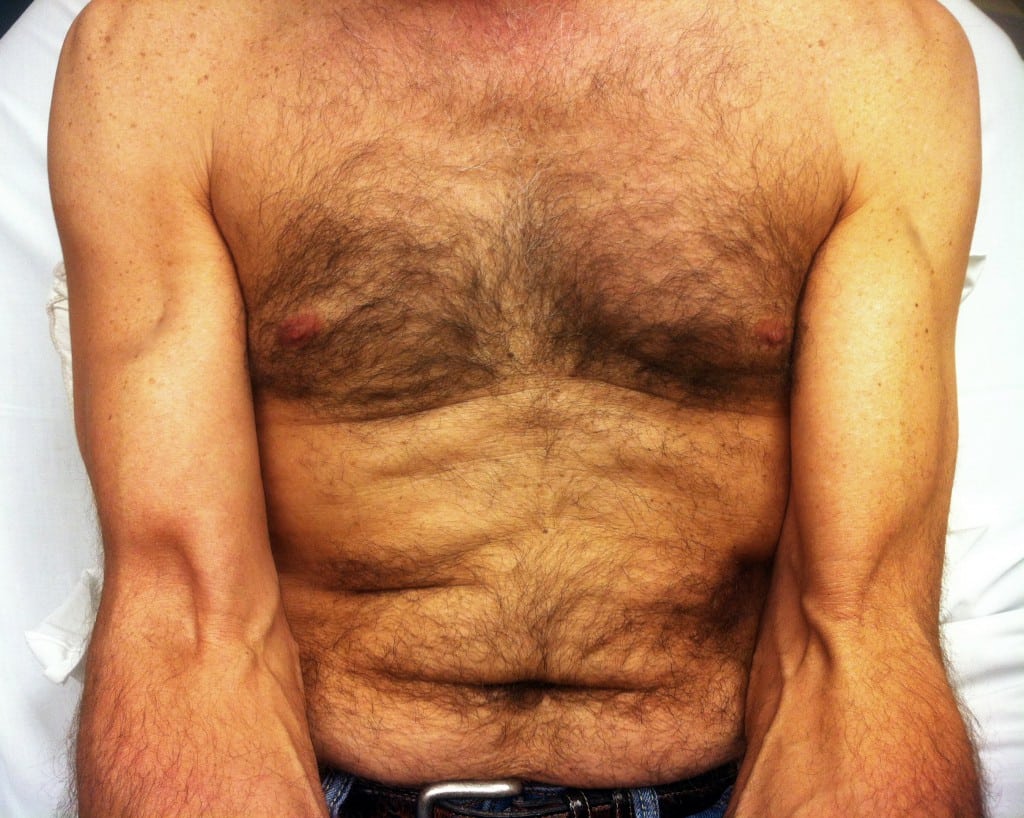| Author | Affiliation |
|---|---|
| Meghan Galer, MD | Madigan Army Medical Center, Department of Emergency Medicine, Tacoma, Washington |
| Jason Heiner, MD | University of Washington Medical Center, Division of Emergency Medicine, Seattle, Washington |
A healthy 58-year-old man presented to the emergency department with right arm weakness first noticed while playing hockey that day. He could not recall the onset of injury, but endorsed several weeks of antecedent intermittent right shoulder discomfort. Examination revealed a deformity of the right biceps brachii with distal bunching of the muscle (Figure). Tenderness existed along the proximal humerus near the long head of the biceps. The patient had full range of motion with decreased elbow flexion strength on the right. He was diagnosed clinically with an acute biceps brachii tendon rupture.
Acute biceps tendon rupture most commonly occurs at the proximal end of the long head of the biceps brachii and is usually associated with trauma. Acute biceps tendon rupture frequently occurs in patients with underlying overuse injuries and tendinopathies—thus the actual moment of rupture may go unnoticed.1–4 While the diagnosis can generally be made by history and physical examination, ultrasound and magnetic resonance imaging can aid in diagnosis.1–4 Most injuries are managed conservatively and the typical post-injury reductions in strength are mild to moderate and well tolerated.2–5 Surgical management may lessen loss of elbow flexion and supination strength and may be considered in the management of highly active patients.3,5
This patient underwent surgical open subpectoral biceps tenodesis with successful resolution of his biceps contour and restoration of full strength and mobility.
Footnotes
Full text available through open access at http://escholarship.org/uc/uciem_westjem
Address for Correspondence: Meghan Galer, MD, Madigan Army Medical Center, Department of Emergency Medicine. 9040 Fitzsimmons Avenue, Tacoma, WA 98431. Email: meghan.galer@gmail.com. 7 / 2014; 15:351 – 351
Submission history: Revision received November 17, 2013; Submitted December 18, 2013; Accepted January 6, 2014
Conflicts of Interest: By the WestJEM article submission agreement, all authors are required to disclose all affiliations, funding sources and financial or management relationships that could be perceived as potential sources of bias. The views expressed are those of the author(s) and do not reflect the official policy of the Department of the Army, the Department of Defense or the U.S. Government.
REFERENCES
1 Harwood MI, Smith CT Superior labrum, anterior-posterior lesions and biceps injuries: diagnostic and treatment considerations. Prim Care. 2004; 31:831-855
2 Deutch SR, Gelineck J, Johannsen HV Permanent disabilities in the displaced muscle from rupture of the long head tendon of the biceps. Scand J Med Sci Sports. 2005; 15:159-162
3 Klonz A, Loitz D, Reilmann H Proximal and distal ruptures of the biceps brachii tendon. Unfallchirug. 2003; 106:755-763
4 Mariani EM, Cofield RH, Askew LJ Rupture of the tendon of the long head of the biceps brachii: surgical versus nonsurgical treatment. Clin Orthop Relat Res. 1988; 228:233-239
5 Sturzenegger M, Beguin D, Grunig B Muscular strength after rupture of the long head of the biceps. Arch Orthop Trauma Surg. 1986; 105:18-23



